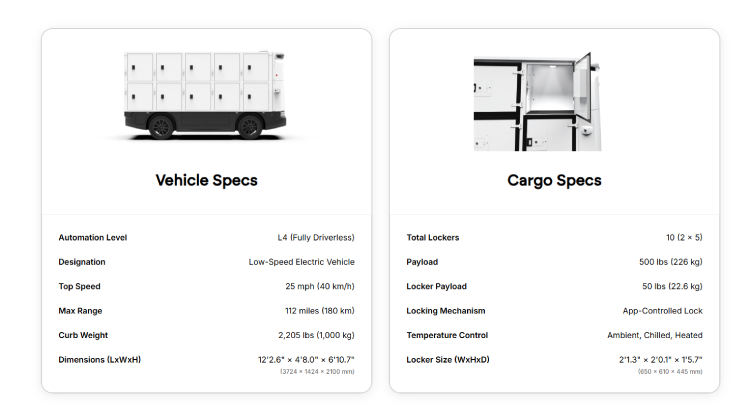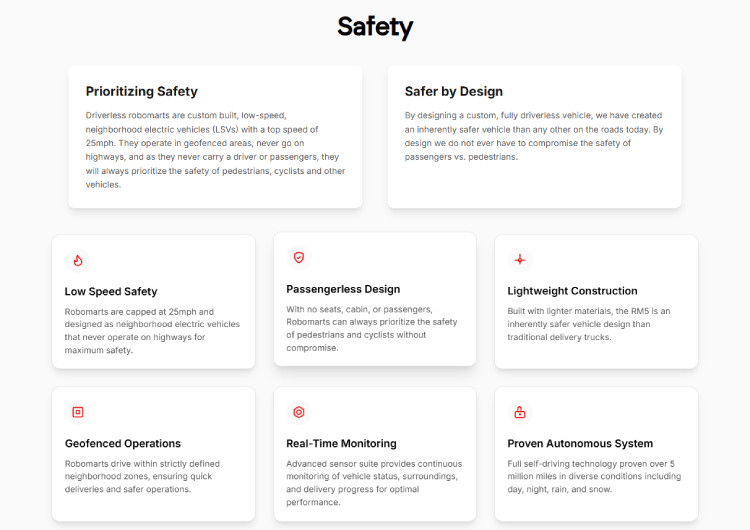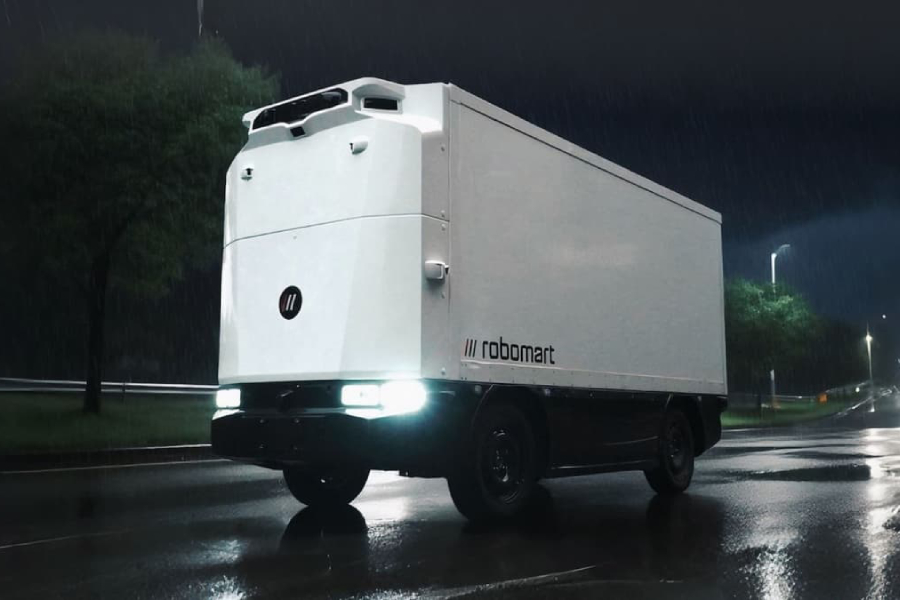In August 2025, Los Angeles–based start-up Robomart officially unveiled its fifth-generation autonomous delivery robot, the Robomart RM5. The launch is not just another technical milestone; it is seen as a direct challenge to the current food-delivery model. According to the company, Robomart plans to onboard its first retail partners in Austin, Texas, in the coming months and aims to begin commercial delivery service later this year.
Resembling a small vending machine that can weave through city streets, the RM5 could reshape how we shop and how the delivery industry operates.
The Hard-Core Features of Robomart RM5
RM5 is more than a robot that simply moves goods. It bundles several core technologies intended to solve long-standing pain points in traditional food delivery.
First is Level-4 autonomous-driving capability. This means Robomart RM5 can complete the entire delivery—from the retailer to the customer’s doorstep—without any human remote monitor or safety driver. It can plan its own route, avoid obstacles, recognize traffic lights, and park safely at the destination. This high degree of automation is the key to low-cost operations.
Second, large capacity and modular design greatly boost delivery efficiency.Robomart RM5 has a maximum payload of 500 pounds (about 227 kg) and ten independent lockers. One robot can therefore carry multiple orders at once, turning the “one trip, one order” model into “one trip, many orders,” slashing per-delivery costs. The modular cargo bay also lets the robot switch between product categories—whether fresh food, pharmaceuticals, or everyday groceries—without difficulty.
What truly grabs attention is Robomart’s disruptive flat-fee pricing model: customers pay only 3 for doorstep delivery. The price is transparent and fixed, with none of the service fees, platform fees, or tips common on traditional apps.

Robomart’s New Business Model: From “Mobile Store” to “On-Demand Delivery Platform”
Robomart’s business model has continued to evolve. What began as a “mobile store” (bringing the shop to your curb) has now become an “on-demand delivery platform,” putting it in direct competition with Uber Eats, DoorDash, and similar giants.
For retailers, partnering with Robomart is like opening an online storefront. They list products in the Robomart app; when a customer orders, the robot drives itself to the retailer, picks up the items, and delivers them directly. Retailers avoid the need to build their own delivery fleets and gain a new sales channel.
For consumers, the experience is simple and convenient: open the Robomart app, choose a store and items, place the order, and the RM5 drives itself to the curb. To collect the order, the customer scans a QR code in the app, the assigned locker pops open, and the goods are in hand. The entire process is fully automated, saving time and hassle.
Why Robomart RM5 Could Rewrite the Rules
Robomart RM5 is viewed as a potential game changer because it fundamentally disrupts cost structures.
First is the cost killer. According to Robomart, robot delivery costs up to 70 % less than human delivery. A traditional human courier averages 9–10 per order, whereas RM5 comes in around 3. This massive cost advantage translates directly into lower prices for consumers.
Second is price transparency. Traditional apps often lure users with modest delivery fees, but the final bill balloons with service fees, platform fees, and tips, frequently exceeding 10. Robomart’s fixed 3 fee is both highly competitive and trustworthy.
In addition, efficient capital use has been critical. Robomart completed five robot generations on less than 5 million in funding, demonstrating both technical feasibility and disciplined spending—especially notable in the autonomous-driving sector, where budgets can easily reach hundreds of millions.
Finally, Robomart has seized a market void. While many companies are developing autonomous delivery vehicles, Robomart is the first to put a true “autonomous food-delivery platform” into practice. In this niche, it currently has no direct competitor.

Next Challenges and Outlook for Robomart RM5
Despite its promise, scaling Robomart RM5 still faces hurdles.
First are the initial real-world metrics from Austin. Robomart must prove its delivery-success rate, average delivery time, and customer-satisfaction scores in an actual city environment. These numbers will determine whether the model is truly viable.
Second is regulatory approval. To replicate Level-4 operations nationwide, Robomart needs permits from multiple jurisdictions. Success depends not only on technical maturity but also on policy support.
Last is competitor response. Faced with Robomart’s impact, traditional delivery platforms might slash fees or accelerate their own robot programs. How they react will be a key storyline in the year ahead.
In the near future, autonomous delivery robots like Robomart RM5 could become part of daily life. They may not only reshape the food-delivery landscape but also spark entirely new business models. By taking this first step, Robomart has sketched an imaginative future for the entire industry.



